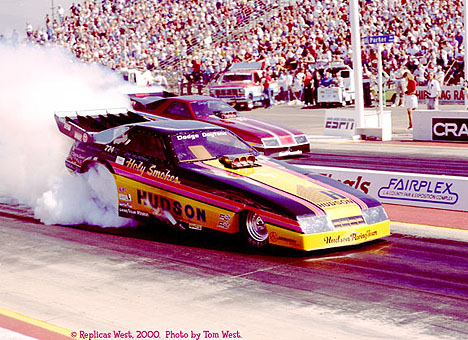What Caused the Loss of the SoCal Drag Strips?
By Tom West

Tom West has been part of the SoCal scene for years. Here he shoots
Jim Murphy's Funny Car in around '88 or '89. Photo by Tom West
One of our Draglist readers posed the title question to me a while ago, and I asked the veteran racers and railbirds of the Standard 1320 group for their opinion. Tom West took shots of all the action from the magical '70s and offers his opinion here. bp
I do not consider myself an expert in the subject of track closings either in Southern California or around the country. There seem to be a variety of factors that have forced the closure of tracks, but I can put together some of the things that ended things for me out here.
I came out to the LA area from Denver at the beginning of my senior year of high school in the fall of 1965. My first event was a huge MT 200 MPH Club race at Fontana. I only ended up going there one more time in the seven years that I was involved in drag racing and photography. I went to the March Meet in 1966, which completely floored me, then to the Hot Rod Meet at Riverside Raceway. This was before I jumped in and started doing something seriously. Every weekend I could hear the cars from Irwindale as the sound bounced off the San Gabriel Mountains and reflected into the Valley. It just reinforced the fact that I had to get more involved in the sport.
I went to Irwindale about a month after getting out of high school and was able to convince Steve Gibbs to let me out on the starting line, and that was the beginning for me. That fall, I went to Long Beach for the first time to see the Super Stock Magazine East-West Funny Car race, which was one of the cooler things that I had seen. I later worked my way into OCIR and began about a five year rotation between Lions-Irwindale-OCIR, with trips to Pomona for the Winternationals, Bakersfield for the March Meet and Points Meets, Carlsbad (once), and Ontario for the Supernationals.
There was an extremely active racing situation out here through 1971, with sometimes three tracks to choose from on a particular weekend. For the major events, the tracks would not run their big stuff against the headline events. But on "off" weekends, there would be equally good events running as normal shows, one track running open qualifying for an 8-car FC show, another running 8 Top Fuel, 4 Top Gas, etc., and the other running something like A/GS, wheelstanders and something else. All of these would have a whole pit full of cars trying to qualify most of the time.
At the beginning of 1972, things started to drop off. I was realizing that there were times when I was skipping a couple of weeks between shows. It was really the announcement and closing of Lions that did it for many of us. When that closed, many people that I have spoken with have said that this was the end of the line for their involvement. For me, I moved East to Long Island in March of 1973.
All of the tracks out here went to schedules that were more sporadic and spread those major shows out. I think the next to close was Irwindale, then OCIR. Fontana went away, along with Riverside, San Fernando, and Ontario. Almost all of these because of pressures from surrounding areas, and the financial drop in the operations as businesses.
As far as when the interest in the muscle cars hit, compared to some of these events, I would say that it all occurred around the same time. Cars went from 450 horsepower Muscle Cars to 30-mpg transportation. The emphasis changed, the advertising changed, and the direction changed. It all had to have an impact, but I think it was about like anything else that is really hot: people move on. Remember that this was essentially hobby racing back then. What you had was tons of hobby racers out there supporting this, with a few pro touring folks mixed in. There weren't any of the major sponsors around until the Hot Wheels deals, and the first Army contract around '73 or '74 was probably the first real big money sponsorship. You now have a situation where few people can afford to race as a hobby, so you have a smaller number of Pro racers in the top classes.
When all those top class hobby racers went away, there weren't enough cars to support the shows, and the spectators are not going to come out to watch a bunch of street cars. You may end up with more participants, which is good, but it isn't a real draw for the general public.
This was a rather winding read, I am sure. Sorry about that, but this was pretty much the way that I saw it happen.
Tom West
TWestXRAY@aol.com